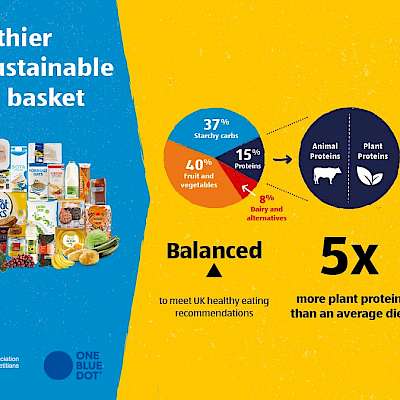This is a guest article by Eating Better alliance organisation the British Dietetic Association on the launch of their sustainable and healthy shopping basket with Aldi supermarket.
Through industry data and our own insight work, we have seen that COVID-19 has changed the way the public are prioritising health and sustainability. Before the pandemic, reports from the Institute of Grocery Distribution showed that two thirds of consumers were open to changing their diets to be healthier and more sustainable.
Our BDA reference guide for dietitians ‘Eating patterns for health and environmental sustainability’ which formed the basis of the initial One Blue Dot toolkit, identified that morphing consumer awareness and intention into behaviour change for the majority would mean overcoming significant barriers. Now however, like so much else in our lives, the picture is more complex.
Most shoppers have always had an interest in the pricing of items and many have an interest in the nutritional quality of items. Increasingly, environmental issues drive the differentiation of choices made. These are complex issues and this project looks at an approach to modelling a healthy, sustainable basket of popular foods, with a further emphasis on being affordable.
For the average customer, moving to a completely sustainable basket can be is a significant change and taking smaller steps towards a more healthy, more sustainable diet is a more realistic and practical approach. We focus on achievable shifts in popular foods which demonstrate the choices people can make to move towards recommendations for healthier and more sustainable shopping baskets.
Our basket was curated by the themes 1) nutritious 2) environmentally sustainable and 3) affordable. Our food-based approach includes criteria which meet Eatwell Guide proportions, selecting items from the most popular categories as defined by the Office of National Statistics, and achieving significant progress towards Eating Better Alliance dietary targets of half (current average) amounts of total meat and dairy by 2030.
Government dietary guidelines supporting human health are based on the consensus of scientific data linking foods and reduction of risk of disease and ill health. Meanwhile the assessment of environmental (planetary) links with food production and distribution are complex; current targets link to parameters known to be critical markers of sustainability e.g. greenhouse gas emissions, biodiversity scores or nitrogen levels. There can never be perfect matching between data on optimal human health and environmental sustainability, but many themes align and are now the familiar messages of moderate intakes of animal proteins, greater intakes of plant proteins and fruits and vegetables, and minimising waste.
We have blended these with pragmatic choices of familiar foods which are appealing to many shoppers. The basket and supporting communications convey the many simple steps towards diets that are nutritionally and environmentally ‘better’ without costing more.
The main themes are increases in plant protein foods without increasing protein overall, greater intakes in fruits and vegetables (compared to current typical consumption levels), greater intakes of wholegrain versus white/refined starchy foods, and reductions in foods high in sugars and salt.
These are all very familiar messages, but need clear and continuous communication, to support both individual and population-wide aspirations for better health. Increasingly the newer but as urgent priorities around the environmental links to food production and distribution need to be considered.
By creating practical resources like these, we can show how these changes impact key environmental and nutritional targets, we can support the public to make the shift and take action towards key targets such as those in Eating Better’s Better by Half.
For more information click here.
